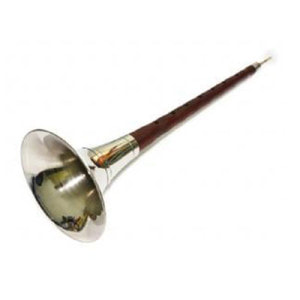Suona
Woodwinds
Asia
Between 0 and 1000 AD
Video
The suona is a traditional Chinese double-reed wind instrument known for its loud, piercing sound and vibrant presence in various musical contexts. It plays a significant role in both ceremonial and folk music, often associated with celebrations, weddings, and funerals.
Description and Purpose
The suona features a conical wooden body, typically made from hardwoods such as rosewood or mahogany, with a flared metal bell at the end. This construction allows it to produce a bright and powerful tone that can easily cut through other sounds in an ensemble. The instrument usually has seven finger holes on the front and one thumb hole on the back, enabling musicians to achieve a wide range of pitches.The primary purpose of the suona is to provide melodic lines in various musical settings. It is commonly used in traditional Chinese music genres, particularly during festive occasions, military ceremonies, and religious rituals. The loud and expressive sound of the suona makes it an ideal lead instrument for outdoor performances, where it can effectively engage audiences and enhance celebratory atmospheres.
History and Origin
The origins of the suona can be traced back to ancient Iran, where a similar instrument called the sorna was played. The suona is believed to have been introduced to China around the 3rd century, evolving into its current form over centuries. It became particularly popular in northern China, where it was integrated into local folk music traditions. The instrument has been used extensively in various cultural contexts, from military music to festive celebrations.Throughout its history, the suona has maintained its significance in Chinese culture. It has been featured prominently in traditional ensembles and is often associated with auspicious occasions due to its powerful sound. In modern times, the suona continues to be an important part of Chinese orchestras and folk music groups.
Working Mechanism
The working mechanism of the suona involves air being blown into a mouthpiece fitted with a double reed. When air passes through the reed, it vibrates against itself, producing sound waves that resonate through the conical body of the instrument. Players can manipulate pitch by covering or uncovering finger holes along the body. The design of the flared bell amplifies the sound, allowing for a wide dynamic range from soft tones to powerful blasts.
Types of Suona
There are several types of suona based on size and pitch:
Soprano Suona: The most common type used in traditional performances, known for its bright and high-pitched sound.
Alto Suona: A larger variant that produces deeper tones suitable for different musical contexts.
Tenor Suona: Similar to the alto but typically tuned lower.
Bass Suona: The largest type, capable of producing very low pitches.
Each type serves specific roles within musical compositions, allowing for a rich tapestry of sound.
Features
The suona is distinguished by several key features. It is known for its bright, loud, and penetrating tone that can project over large ensembles.Typically made from hardwoods or bamboo for the body, with a metal bell that enhances projection.
Finger Holes: The seven finger holes allow for agile fingering and pitch variation.
Cultural Significance: The suona plays an essential role in various Chinese musical traditions and ceremonies, symbolizing cultural heritage.
It is a vital instrument within Chinese music with deep historical roots and significant cultural importance. Its unique sound and versatility ensure its continued relevance in both traditional performances and modern musical expressions.
FAQ
What is the Suona and its Historical Significance?
The Suona is a traditional Chinese double-reed wind instrument that originated from the Middle East and was introduced to China during the Yuan Dynasty (1279–1368). It has been widely used in Chinese folk music, especially in celebrations and ceremonies, symbolizing joy and festivity. The Suona is often associated with important life events such as weddings and funerals, reflecting its deep cultural significance in Chinese society.
How is the Suona Constructed?
The Suona typically features a conical wooden body with a metal bell at the end. It has seven finger holes on the front and one thumb hole on the back for pitch control. The instrument uses a large double reed, which is attached to a metal tube, allowing it to produce a loud and penetrating sound. The combination of materials and design contributes to its distinctive timbre, making it suitable for outdoor performances.
What Role Does the Suona Play in Modern Music?
In modern music, the Suona continues to be an essential instrument in traditional Chinese ensembles, particularly during festivals and cultural events. It has also found its place in contemporary compositions, where composers explore its unique sound in various musical contexts, including orchestral and chamber music. Its ability to convey emotion and energy makes it a favored choice for both traditional and modern performances.
 Links
Links
References
Other Instrument
Categories


















